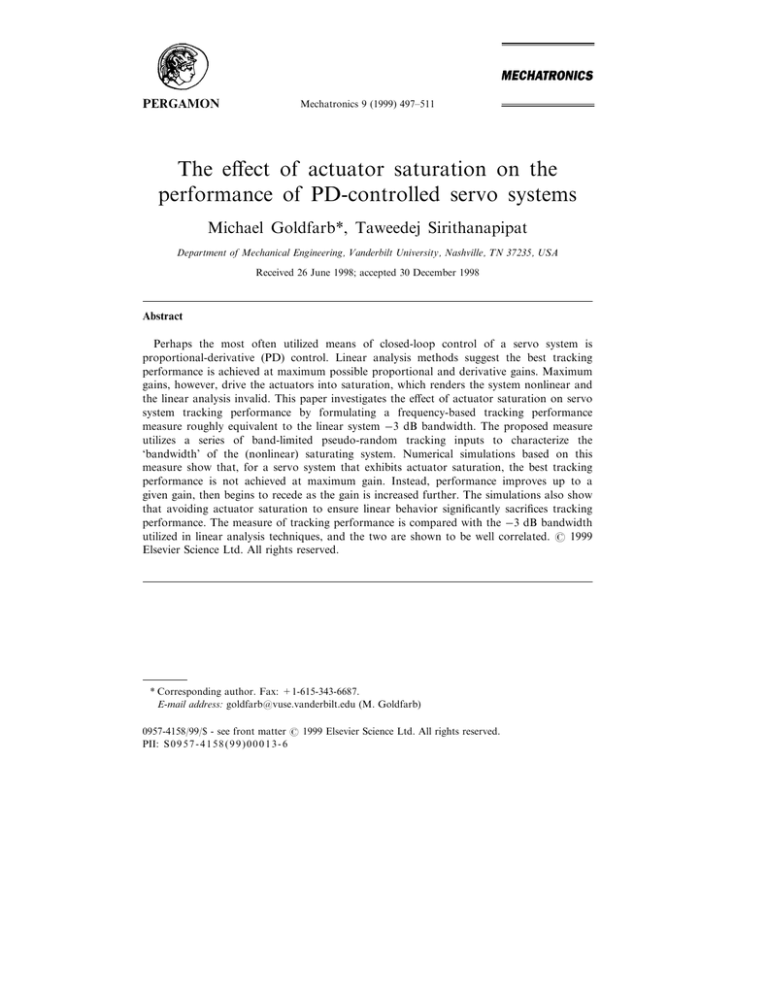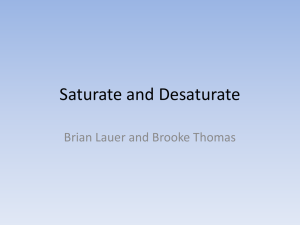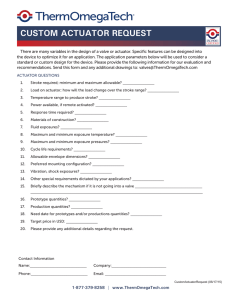
Mechatronics 9 (1999) 497±511
The eect of actuator saturation on the
performance of PD-controlled servo systems
Michael Goldfarb*, Taweedej Sirithanapipat
Department of Mechanical Engineering, Vanderbilt University, Nashville, TN 37235, USA
Received 26 June 1998; accepted 30 December 1998
Abstract
Perhaps the most often utilized means of closed-loop control of a servo system is
proportional-derivative (PD) control. Linear analysis methods suggest the best tracking
performance is achieved at maximum possible proportional and derivative gains. Maximum
gains, however, drive the actuators into saturation, which renders the system nonlinear and
the linear analysis invalid. This paper investigates the eect of actuator saturation on servo
system tracking performance by formulating a frequency-based tracking performance
measure roughly equivalent to the linear system ÿ3 dB bandwidth. The proposed measure
utilizes a series of band-limited pseudo-random tracking inputs to characterize the
`bandwidth' of the (nonlinear) saturating system. Numerical simulations based on this
measure show that, for a servo system that exhibits actuator saturation, the best tracking
performance is not achieved at maximum gain. Instead, performance improves up to a
given gain, then begins to recede as the gain is increased further. The simulations also show
that avoiding actuator saturation to ensure linear behavior signi®cantly sacri®ces tracking
performance. The measure of tracking performance is compared with the ÿ3 dB bandwidth
utilized in linear analysis techniques, and the two are shown to be well correlated. # 1999
Elsevier Science Ltd. All rights reserved.
* Corresponding author. Fax: +1-615-343-6687.
E-mail address: goldfarb@vuse.vanderbilt.edu (M. Goldfarb)
0957-4158/99/$ - see front matter # 1999 Elsevier Science Ltd. All rights reserved.
PII: S 0 9 5 7 - 4 1 5 8 ( 9 9 ) 0 0 0 1 3 - 6
498
M. Goldfarb, T. Sirithanapipat / Mechatronics 9 (1999) 497±511
1. Introduction
The servo control problem is generally characterized by a rotational system with
a position output related to a torque input through the dynamics of inertia,
friction, and sometimes gravity. The objective of a servo control system is
typically to obtain accurate position tracking while maintaining system stability.
Several control techniques exist to achieve this objective. Perhaps the most often
utilized approach is proportional-derivative (PD) control, which utilizes a control
signal consisting of a weighted sum of the position and velocity errors. If not used
in a direct fashion, the PD-control structure often forms the basis for other
commonly-used servo control approaches. For example, a common and closelyrelated approach is computed torque control, which utilizes a model of the control
plant to cancel (typically inertial and gravitational) nonlinearities, then essentially
utilizes a PD-type control on the residual linear system. Additionally, sliding mode
control can also be considered a variant of PD-control, especially for cases in
which the control gains are large relative to the parametric uncertainty of the
model. The fundamental structure of these and many other servo controllers is in
essence a PD control structure.
A signi®cant asset of a PD-controlled servo system is its stable behavior.
Demonstrating the stability of the PD-control of a servo system with linear
Fig. 1. Block diagram representing (a) PD control of a servo system and (b) PD control of servo
system with actuator saturation.
M. Goldfarb, T. Sirithanapipat / Mechatronics 9 (1999) 497±511
499
mechanics is trivial. More signi®cantly, several researchers, including Slotine and
Li [1] and Yigit [2], have demonstrated via Lyapunov methods that the PDcontrol of a servo system with nonlinear inertial and gravitational mechanics (e.g.,
a robot manipulator) also exhibits asymptotic stability.
2. Linear analysis and PD control
Probably the two most signi®cant issues in servo control system design are the
closed-loop system stability and the tracking performance. For a linear (or
linearized) system, the analysis and design of a PD-control system can be guided
by frequency-based techniques. For example, PD control of the linear system with
inertia and damping, as represented by the block diagram of Fig. 1(a), would yield
a closed-loop characteristic equation of:
Js2
B Kd s Kp 0
1
where J is the rotational inertia, B the damping ratio, s the LaPlace variable, Kp
the proportional control gain, and Kd the derivative control gain. This system is
stable for any Kp>0, and as both Kd and Kp approach positive in®nity, the poles
of the system converge to negative in®nity, resulting in an instantaneous response
and thus perfect tracking.
Some prior publications in the engineering literature oer recommendations for
the selection of PD control gains that are consistent with the aforementioned
linear analysis. Shahruz et al. [3] utilize the theory of singularly perturbed systems
to assert that, for PD control of a generalized multi-rigid-link robot manipulator:
``large gain matrices Kp and Kd make the robot manipulator perform better.'' Xu
et al. [4] also recommend that PD gains should be selected ``as high as possible up
to the point that sensor noise causes instability.''
The notion of optimal performance at in®nitely large gains is based on linear
system behavior. The use of large gains, however, inevitably introduces saturation,
which in turn violates the assumption of linearity. The use of large gains (and in
particular in®nite gains) is therefore in direct con¯ict with the assumption of
linear system behavior. Speci®cally, as control gains become large, some
component of the control system (typically the motor servo-ampli®er) is forced
into saturation, thus introducing a distinct nonlinearity (as illustrated in Fig. 1(b))
that in turn invalidates the aforementioned linear analysis. This problem can be
circumvented by limiting the proportional and derivative gains to a level that
avoids actuator saturation. This approach, however, sacri®ces actuator eort (and
thus tracking performance) to gain linear behavior. Such strategy is in direct
con¯ict with the notion of optimal tracking performance, which intuitively should
take full advantage of system resources, and thus deliberately push the actuators
into saturation.
500
M. Goldfarb, T. Sirithanapipat / Mechatronics 9 (1999) 497±511
3. Nonlinear analysis of saturation in control
Several researchers have analyzed the stability of control systems in the presence
of actuator saturation. Kim and Bien [5] present sucient conditions for robust
stability in the presence of actuator saturation. Glattfelder and Schaufelberger [6],
Hui and Chan [7], among others, have investigated the stability eects resulting
from integrator wind-up in the presence of saturating actuators. Sourlas et al. [8]
determined that actuator saturation improves disturbance rejection, which is an
intuitively reasonable result.
Several researchers have proposed speci®c control methodologies that provide
enhanced stability or tracking performance in the presence of actuator saturation.
Frankena and Sivan [9], Ryan [10], and Bernstein [11] derived control laws within
an optimal control framework that included a bounded control constraint to
account for actuator saturation. Derivation of the optimal control laws, however,
required the assumption that the open-loop system is asymptotically stable, which
is quite limiting, since servo systems are typically either marginally stable or
unstable in position. Paden and Tomizuka [12] derived a control law for fast point
to point position control in the presence of actuator saturation, which is
concerned with step inputs, but not with tracking per se. Kabuli and Kosut [13]
derived a control law for trajectory tracking in the presence of actuator saturation
that incorporates a bang-bang type control eort. Goto et al. [14] incorporated
model inversion to pre-compute a control command based on a known desired
trajectory to improve tracking in the presence of actuator saturation. Shewchun
and Feron [15] proposed `high performance bounded control', a control approach
that varies the feedback gains in order to purposefully avoid actuator saturation.
As demonstrated by the simulations presented in this paper, such an approach
may be considerably sub-optimal for purposes of tracking performance.
None of the previously mentioned works has focused on the eects of actuator
saturation on the tracking performance of PD-controlled servo systems. Rather
than propose special control methodologies to accommodate actuator saturation,
this paper treats the more common scenario of incurring actuator saturation
during the PD-control of a servo system. Speci®cally, the paper derives a
generalized measure of tracking performance, and utilizing this measure,
incorporates numerical simulations to demonstrate the relationship between loop
gain and tracking performance in PD-controlled servo systems with actuator
saturation.
4. A measure of tracking performance
Linear control system design often incorporates frequency-based measures, such
as pole locations or frequency response, to assess tracking performance. A
frequency-based measure typically used in the linear case is the ÿ3 dB bandwidth,
which is the frequency at which the system output is generally agreed to no longer
adequately track the reference input. Control gains for optimal tracking
Fig. 2. The band-limited psuedo-random input for frequency-based characterization of tracking performance is generated by passing white noise through a
second-order critically-damped low pass ®lter with cuto frequency of oc.
M. Goldfarb, T. Sirithanapipat / Mechatronics 9 (1999) 497±511
501
502
M. Goldfarb, T. Sirithanapipat / Mechatronics 9 (1999) 497±511
performance are typically selected to maximize the bandwidth while maintaining
unity input/output gain below this frequency.
A linear system can be characterized completely in the frequency domain
because the behavior of such a system can be described solely as a function of the
input frequency. That is, the output of a linear system will be of the same
frequency as the input, subject to a frequency-dependent gain and phase. A linear
system can therefore be characterized by these two components. The performance
of a nonlinear system, however, cannot be similarly characterized, since the output
generally depends upon the input amplitude and frequency, in addition to the
system location in the state space. Characterization of a nonlinear system thus
requires input that is suciently amplitude and frequency rich to assess the
tracking performance throughout the state space.
The authors have derived a generalized measure of tracking performance for
nonlinear systems to evaluate the eect of actuator saturation on the performance
of a PD-controlled servo system. The tracking performance characterization is
based loosely on the construction of a linear system Bode plot. Rather than utilize
a sinusoidal input with a single amplitude and frequency, however, the
characterization technique utilizes a band-limited pseudo-random input that is
devised by passing white noise through a second-order critically-damped low-pass
®lter, given by:
H
s
1
s o c 2
2
The resulting signal contains primarily frequencies up to the cuto frequency oc,
which are approximately uniformly distributed, and signi®cantly less frequency
content above the cuto, as illustrated in Fig. 2. For purposes of performance
characterization, the `frequency' of this signal is identi®ed by that of the ®lter
cuto, oc. The amplitude of the output is also normalized for the appropriate
bounds of the coordinate space (or workspace, as the case may be). Fig. 3 shows
examples of these band-limited psuedo-random signals for cuto frequencies of
0.1, 1.0, and 10.0 Hz, and for signal amplitudes normalized to a workspace of
2458. Rather than using a combination of magnitude and phase, the tracking
performance at a given `frequency' is characterized by the root-mean-square
(RMS) tracking error, which is normalized to the RMS of the input signal and
referred to as the normalized RMS tracking error. More speci®cally, the RMS
error is given by:
erms
1
T
T q
y ÿ yd 2 dt
0
3
where y is the output, yd is the input command, and T is the tracking duration;
the RMS of the input signal is given by:
M. Goldfarb, T. Sirithanapipat / Mechatronics 9 (1999) 497±511
503
Fig. 3. Band-limited psuedo-random input signals for cuto frequency of 0.1, 1.0, and 10.0 Hz. The
signal amplitudes were normalized for a desired workspace of 2458. The minimum value of the 10 Hz
signal is ÿ458. The data shown do not appear to reach this value because they were thinned for
graphical presentation.
504
M. Goldfarb, T. Sirithanapipat / Mechatronics 9 (1999) 497±511
urms
q
1 T
yd ÿ yo 2 dt
T 0
4
where yo is any DC component of the input signal; and ®nally, the normalized
RMS tracking error given by:
e rms
erms
urms
5
Perfect tracking performance is indicated by a normalized RMS tracking error of
zero, while no response whatsoever to the input command would result in a
normalized RMS tracking error of one. In a manner similar to a linear Bode plot,
this measure is taken across the frequency spectrum (by varying the ®lter cuto,
oc) to construct a measure of tracking performance across the `frequency'
spectrum. A typical loop shape generated by this performance measure is
illustrated in Fig. 4. As shapes are generally dicult to compare, one can choose a
value of the normalized RMS error that represents the extent of good tracking,
and associate a bandwidth with that value. Selection of the value of error that
corresponds to the bandwidth is somewhat arbitrary (as is the choice of ÿ3 dB),
but also conceptually unimportant. For the purposes of this work, the `bandwidth'
of the system is characterized by a normalized RMS tracking error of one half,
Fig. 4. An example of a loop shape obtained by the normalized RMS error method, along with an
indication of the `bandwidth' determined by a normalized RMS error of 0.5.
M. Goldfarb, T. Sirithanapipat / Mechatronics 9 (1999) 497±511
505
which is depicted in the normalized RMS error loop shape plot of Fig. 4 and
corresponds to a time-based performance such as that shown in Fig. 5. Having
established a tracking performance measure, the tracking performance of a servo
system can be mapped as the control system gains are varied.
5. The eects of actuator saturation
The previously described tracking performance measure is utilized on a
simulated single degree-of-freedom servo system in order to demonstrate the eect
of actuator saturation on a PD controlled servo system. The simulated system,
which is assumed to move in the horizontal plane without signi®cant bearing
friction, is described (without saturation) by the closed-loop characteristic
equation:
Js2 Kd s Kp 0
6
Also, to simplify the illustration, the authors reduce the two degree-of-freedom
gain selection problem (selection of Kp and Kd) to a single degree-of-freedom
problem by constraining the (linear) closed-loop characteristic equation to a
damping ratio of unity. The derivative gain is therefore given by:
p
7
Kd 2 JKp
Fig. 5. Time-based tracking of a signal that represents a performance corresponding to a normalized
RMS error of 0.5.
506
M. Goldfarb, T. Sirithanapipat / Mechatronics 9 (1999) 497±511
As a result, the gain selection can be discussed in terms of a single loop gain, Kp.
To enable comparison, the closed-loop servo system was characterized for both
the purely linear case (no actuator saturation) and the case with saturation. The
model parameters are the rotational inertia, given by J=0.06 kg m2, and the
actuator saturation level, which was set at Tmax=7.5 Nm, both selected to model
an existing servo system. The system was simulated at nine gain sets, as shown in
Table 1. Tracking performance at each gain set was measured at twelve input
frequencies (as determined by oc) between 0.1 and 100 Hz. The trajectory inputs
were all normalized to a maximum amplitude of positive or negative 458. Tracking
inputs for 0.1, 1.0, and 10.0 Hz are shown in Fig. 3.
The dependence of the normalized RMS error on the duration of the input was
investigated by comparing the measured error for several dierent inputs lasting in
duration from 1±10 s. The results showed that, for the system simulated, the
normalized RMS error for the lowest tested frequency (0.1 Hz) converged after
approximately 5 s. Each normalized RMS error was therefore taken for a 10 s
input duration, to ensure convergence.
The tracking performance of the linear (no saturation) and nonlinear (with
actuator saturation) closed-loop systems, as given by the previously described
frequency-based normalized RMS error method, is shown in Figs. 6 and 7,
respectively. These ®gures are roughly analogous to a set of linear system Bode
plots (each plot representing a dierent set of gains), but characterize tracking
performance across the frequency spectrum with normalized RMS error rather
than as a combination of magnitude and phase. As expected with the linear
system, the overall tracking performance improves (smaller normalized RMS
error) with increasing gain. Unlike the linear system, however, the overall
performance of the saturating (nonlinear) system improves with increasing gain up
to a point, at which point the system hits a `performance wall', beyond which the
performance degrades with increased loop gain.
The distinction between linear and nonlinear (saturating) behavior is
additionally illustrated by comparing the 0.5 normalized RMS error `bandwidth'
Table 1
PD gain sets corresponding to a closed-loop damping ratio of unity. The gain set numbers given correspond to the labels in Figs. 6 and 7
Gain set
Kp
Kd
1
2
3
4
5
6
7
8
9
0.024
0.095
0.6
2.4
9.5
60
237
947
5920
0.08
0.15
0.38
0.75
1.51
3.8
7.6
15
38
M. Goldfarb, T. Sirithanapipat / Mechatronics 9 (1999) 497±511
507
Fig. 6. Normalized RMS error plot characterizing tracking performance across the frequency spectrum
for the linear system of Fig. 1(a) at several dierent gain sets. Each plot is labeled with the
corresponding gain set number, as given in Table 1. The 0.5 normalized RMS error `bandwidth' is the
frequency at which each curve crosses the 0.5 RMS error level. Note that, as expected for the linear
system, the tracking performance improves with increased loop gain.
for each case, as shown in Fig. 8. This plot shows clearly that the linear and
nonlinear systems behave similarly at low gains (Kp R 1), but quite dierently at
higher gains, where the actuator saturation becomes signi®cant. The plot also
shows the optimal gain, as given by the 0.5 normalized RMS error measure, is at
Kp110, which corresponds to a `bandwidth' of approximately 2.2 Hz. Note that if
the PD control gains were chosen to avoid saturation in the interest of linearity
(Kp 1 1), the closed-loop bandwidth would be less than half of the maximum
possible. This is not surprising, as optimal performance should maximally utilize
the system resources, and thus regularly push the actuators into saturation. Fig. 9
illustrates the time-based dierence in performance between avoiding actuator
saturation (Kp11) and utilizing actuator saturation (Kp110).
The simulations therefore show two signi®cant features of a PD-controlled
servo system with actuator saturation. First, avoiding actuator saturation to
ensure linear behavior signi®cantly sacri®ces system performance. Second, the best
tracking performance is not necessarily achieved at the maximum obtainable gain.
Rather, performance improves up to a given gain, then begins to recede as the
gain is increased further. Though the PD control structure is quite simple, the
results have conceptual implications for feedback linearization and sliding mode
508
M. Goldfarb, T. Sirithanapipat / Mechatronics 9 (1999) 497±511
Fig. 7. Normalized RMS error plot characterizing tracking performance across the frequency spectrum
for the nonlinear (saturating) system of Fig. 1(b) at several dierent PD gain sets. Each plot is labeled
with the corresponding gain set number, as given in Table 1. Note that the performance improves up
to a given gain (gain set 5), at which point the system hits a `performance wall', then begins to recede
as the gain is increased further.
approaches as well, since for a servo system, all three control approaches are of a
similar structure.
6. Correlation of proposed measure with linear bandwidth
As a matter of interest, the 0.5 normalized RMS error bandwidth found for the
linear system (shown in Fig. 8) can be compared to the ÿ3 dB bandwidth. The ÿ3
dB bandwidth of the closed-loop linear servo system of Eq. (6) can be found from
the closed-loop transfer function, given by:
1
Kp Kd s
H
s jsjo J
Kp
Kd
s
s2
J
J
8
and solving for kH
jo k ÿ3 dB 0:708, which simpli®es to the following
equation:
M. Goldfarb, T. Sirithanapipat / Mechatronics 9 (1999) 497±511
509
Fig. 8. Summary of tracking performance vs loop gain for linear and nonlinear (saturating) systems.
The optimal gain for the system with actuator saturation is Kp 1 10, which corresponds to a
`bandwidth' of approximately 2.2 Hz. Note that if the PD control gains were chosen to avoid
saturation in the interest of linearity (Kp11), the closed-loop bandwidth would be less than half of the
maximum possible.
K 2p
Kp
K 2d
2
o ÿ
2
ÿ
0
o
J2
J
J2
4
9
where o is the ÿ3 dB bandwidth in rad/s. Table 2 shows the closed-loop system
bandwidths for several gain sets as characterized by both the ÿ3 dB and 0.5
Table 2
Comparison of ÿ3 dB bandwidth and 0.5 normalized RMS error bandwidth for a linear system
Kp
Kd
ÿ3 dB BW (Hz)
0.5 norm RMA error BW (Hz)
0.024
0.095
0.6
2.4
9.5
60
237
0.08
0.15
0.38
0.75
1.51
3.8
7.6
0.26
0.5
1.25
2.48
4.97
12.5
25.0
0.31
0.39
0.75
1.55
3.5
10.0
27.0
510
M. Goldfarb, T. Sirithanapipat / Mechatronics 9 (1999) 497±511
Fig. 9. Time-based tracking history for input signal with fc=2 Hz for (a) Kp11 (avoiding saturation to
maintain linear behavior) and for (b) Kp110 (utilizing actuator saturation). Note also that the tracking
in (b) yields a normalized RMS error of 0.5, and thus corresponds closely to the `bandwidth' of the
system, as de®ned by the devised characterization.
normalized RMS error performance measures. As shown in the table, both
measures are fairly well correlated.
7. Conclusion
A generalized measure has been proposed for tracking performance
characterization and utilized to demonstrate the eect of actuator saturation on
PD-controlled servo systems. Numerical simulations of a simple servo system with
actuator saturation give rise to two signi®cant observations. First, and not
surprisingly, avoiding actuator saturation signi®cantly impairs tracking
performance. Second, and more interestingly, large gains can degrade the tracking
performance of a PD-controlled servo system.
References
[1] Slotine JJ, Li W. Applied nonlinear control. Prentice Hall, 1991.
[2] Yigit A. On the stability of PD control for a two-link rigid-¯exible manipulator. ASME Journal of
Dynamic Systems, Measurement, and Control 1994;116:208±15.
[3] Shahruz SM, Langari G, Tomizuka M. Design of robust PD-type control laws for robotic manipulators with parametric uncertainties. In: Proceedings of the American Control Conference, 1992. p.
2967±8.
[4] Xu Y, Hollerbach JM, Ma D. A nonlinear PD controller for force and contact transient control.
IEEE Control Systems Magazine, 1995. p. 15±21.
[5] Kim JH, Bien Z. Robust stability of uncertain linear systems with saturating actuators. IEEE
Transactions on Automatic Control 1994;39:202±7.
M. Goldfarb, T. Sirithanapipat / Mechatronics 9 (1999) 497±511
511
[6] Glattfelder AH, Schaufelberger W. Start-up performance of dierent proportional-integral-antiwind-up regulators. International Journal of Control 1986;44:493±505.
[7] Hui K, Chan CW. New design methods of actuator saturation compensators for proportional,
integral and derivative controllers. Proceedings of the Institution of Mechanical Engineers
1997;211:269±80.
[8] Sourlas D, Choi J, Manousiouthakis V. Best achievable control system performance: the saturation
paradox. In: Proceedings of the IEEE Conference on Decision and Control, 1994. 4. p. 3816±3818.
[9] Frankena JF, Sivan R. A nonlinear optimal control law for linear systems. International Journal
of Control 1979;30:159±78.
[10] Ryan EP. Optimal feedback control of saturating systems. International Journal of Control
1982;35:521±34.
[11] Bernstein DS. Optimal nonlinear, but continuous, feedback control of systems with saturating
actuators. International Journal of Control 1995;62:1209±16.
[12] Paden R, Tomizuka M. Discrete time point to point position control of a system with actuator
saturation. In: Proceedings of the American Control Conference, 1995. p. 1010±4.
[13] Kabuli MG, Kosut RL. Fast ®nite-time tracking with saturating actuators. In: Proceedings of the
IEEE Conference on Decision and Control, 1991. p. 2883±4.
[14] Goto S, Nakamura M, Kyura N. Trajectory generation of industrial mechatronic systems to
achieve accurate contour control performance under torque saturation. In: Proceedings of the
IEEE Conference on Robotics and Automation, 1995. p. 2401±6.
[15] Shewchun JM, Feron E. High performance bounded control. In: Proceedings of the American
Control Conference, 1997. p. 3250±4.





